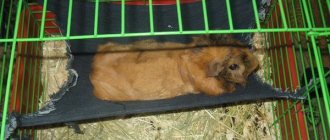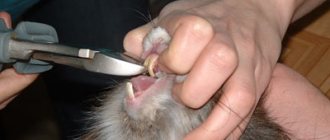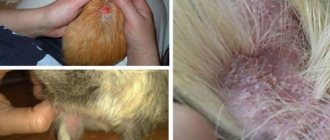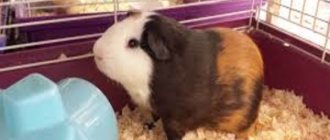A runny nose in a guinea pig, like a cold, usually occurs due to the fault of the animal's owner. The most common cause of colds in pets is non-compliance with the rules of care and maintenance. If your pig shows characteristic signs of a cold (runny nose, cough, sneezing, inactivity and refusal to eat), you need to take immediate action. You should not hesitate in the hope that the animal’s body will defeat the disease on its own - this will not happen. If left to its own devices, the disease will kill the pig in a short time. A cold is dangerous for an animal - it can quickly develop into rhinitis, bronchitis or pneumonia, so if you notice signs of a cold in your pig, you need to start treatment immediately.
What can cause a guinea pig to catch a cold?
By nature, animals have a strong immune system, which loses its strength if the pig is not kept properly and the requirements for caring for it are not met. The main reason why a guinea pig gets a cold is hypothermia. This condition occurs if:
- the temperature of the pet’s environment is less than +18° C;
- the rodent is in a draft or near the air conditioner;
- after bathing, the pet’s coat is not wiped dry enough;
- water procedures are too frequent.
These are the most common causes of hypothermia. They also include infection from the owner - a pig can catch a cold from a sick person. Therefore, if there is a cold, the owner of a rodent should reduce communication with the pet to a minimum until it recovers.
An incorrectly formulated diet significantly contributes to the occurrence and development of the disease in a guinea pig. Especially if the deviation from the recommended menu concerns vitamins (mainly C) - the less the pet’s body receives these elements, the higher the risk of a cold. The lack of fresh fruits, vegetables and herbs in your pet’s diet greatly increases the likelihood of illness.
Care and maintenance at home
Caring for representatives of the rosette breed is not difficult. For maintenance you will need a spacious cage and a standard set of equipment - a feeder, a drinking bowl, a hay barn, and a house. All this must be purchased in advance. To care for the coat, you need a special comb. In addition to the above, the pig will need filler.
Cell
Rosette guinea pigs need a comfortable home. At least 0.7 m2 of free space is allocated for each adult. If the rodent lives alone, you will need a cage measuring 100x70 cm. The recommended height of the structure is 40 cm. If you plan to build a second level, then the last parameter is increased to 60-70 cm.
Main requirements for the cage:
- ease of cleaning;
- good ventilation.
The rosette pig's home can be made of metal or wood. It’s good if it is equipped with a retractable plastic tray - it’s easy to clean. An aquarium is not exactly a suitable place to keep a rodent. All its walls are solid, and air enters only from above. In this case, vapors of ammonia and hydrogen sulfide, which are released from the feces and urine of the rodent, will accumulate inside. This is harmful to the health of rosette pigs.
Interior arrangement
Each guinea pig of the rosette breed needs its own resting house, measuring 50x20, 10-12 cm high. The rodent hides inside when it wants to sleep or is afraid. Filler is placed at the bottom of the cage. This could be torn paper or compressed sawdust. If the choice fell on wood shavings, then you need to make sure that it does not contain coniferous species. The essential oils contained in this filler cause allergies and can cause swelling of the respiratory tract.
Rosette guinea pigs will need a hay barn, two feeders - for grain mixture and vegetables, and a drinking bowl. It is convenient to use a nipple one, since it cannot be tipped over, and the water in it stays fresh longer. The drinking bowl is attached to one of the walls of the cage from the outside; inside there is only a spout with a ball at the end. When the pig wants to drink, she pushes it with her tongue, at which point water begins to flow into her mouth.
If there is enough space in the cage, you can place tunnels inside. If there is a second level, you will need gentle stairs with transverse slats. But they need to be well secured so that the pig does not fall and get injured.
Where to put the cage
Rosette guinea pigs do not tolerate temperature fluctuations. Therefore, it is necessary to choose a suitable location for the cage in the house. It shouldn't be too hot or cold there. The optimal thermometer readings are from 20 to 25 degrees.
The rodent's home should not be placed near a radiator or in a draft. The pig should be protected from direct sunlight to prevent it from overheating.
How to tell if your guinea pig has a cold
The animal's illness affects its behavior. Sneezing, coughing and runny nose are the main symptoms of a cold, but they are not the only ones. Sick rodent:
- Often rubs the muzzle (especially the nose);
- refuses food;
- snorts;
- breathes heavily (sometimes wheezing can be heard);
- looks weak and lethargic;
- remains motionless for a long time (most often lies, but can also sit).
The eyes of a pet with a cold turn red and the eyelids swell. In addition to a runny nose, there may be discharge from the eyes (tears or pus). The fur coat becomes dull and appears disheveled. The animal's body temperature rises. A sick pet often prefers to be in the far corner of his house and rejects all attempts by the owner to pull him out of the found “shelter”.
If these signs are detected, you should take the rodent to a veterinarian as soon as possible. Delay in seeking medical help will lead to the death of your pet.
Signs of a Dying Pet
If the guinea pig is healthy, nothing bothers it, the food is good, there is water and there is no reason for stress, it will be constantly on the move, actively eat food, its eyes will be shiny, and its behavior will be friendly. Such a pet responds with pleasure to games and is distinguished by cleanliness.
If a guinea pig dies, this can be determined by characteristic signs:
- Dull gaze, cloudy cornea;
- coordination of movements is severely impaired, the animal limps, limps, its movement around the cage is difficult, it often falls to the side for no apparent reason;
- completely or partially refuses food (even if she is offered her favorite treat), stops drinking water;
- instead of the usual active movements, the pig sits for a long time in a hunched state, on its back or on its side;
- rapid breathing, wheezing may be heard;
- the animal stops responding to external stimuli, does not notice the owner, tries to hide in the far corner of its home;
- the animal becomes unclean and stops cleaning its coat;
- hair falls out in large quantities, bald patches appear;
- lumps of unknown origin may be felt under the skin;
- the joints of the limbs and fingers become noticeably thicker.
Even if there are none of the listed symptoms, but it becomes noticeable that the animal sleeps most of the time, you should be wary.
Guinea pig snot
A runny nose in a rodent is a symptom not only of a cold, but also of bronchitis, rhinitis, pneumonia, and allergies.
With allergies, a guinea pig's snot is liquid and transparent. In addition, the animal’s eyes usually run red and runny, hair falls out, and there are rashes on the skin. The following may act as an allergen:
- feed;
- filler;
- hay;
- houseplants;
- dust;
- chemicals;
- pungent odors, etc.
The basis of treatment is not only taking the medications prescribed by the veterinarian, but also eliminating the causative agent of the allergy.
In any case, if your pet has a runny nose, you should immediately consult a doctor.
Drinking regime and nutrition
It is more convenient to feed a guinea pig with ready-made concentrated food, at the rate of 20 g per kilogram of animal weight. If you give crackers, white bread or crispbread as a treat, you should know that such food is part of the finished food. Therefore, it must be given in accordance with the permissible volume.
It is worth adding 50 grams of succulent feed and fresh hay to the finished concentrated mixture. This type of feeding allows you to maintain the pig’s health at a high level, since all food has a balanced composition and is rich in vitamins and minerals.
Water is of great importance for rodents. Therefore, it is worth washing the sippy cup every day and pouring fresh, clean water. As vitamins, you can add ascorbic acid to the sippy cup at the rate of 30 ml per 100 ml of liquid. Vitamin C solution can be obtained from a veterinary clinic or pharmacy.
Why does a guinea pig cough?
There are many reasons why an animal may cough. Coughing is a protective reflex that clears the respiratory system of irritants. The causative agents of cough are both infections and foreign objects that accidentally enter the respiratory tract. As for diseases, cough most often accompanies:
- cold;
- bronchitis;
- pneumonia;
- pulmonary edema;
- dental diseases;
- parasite infestation;
- heart problems.
If your pet coughs, you should immediately go to the doctor without wasting time trying to figure out the cause of the cough on your own. The same rule applies to sneezing, wheezing and other abnormalities in the pet’s well-being. The sooner the animal is under the control of professionals, the greater the chances of soon seeing it healthy and vigorous.
Possible complications of the disease
Prolonged ignoring of pathology leads to serious complications:
- anosmia - partial or complete loss of smell;
- decreased local immunity;
- inflammation of the trachea, larynx, ears, eyeballs;
- deterioration of memory and intelligence;
- hearing problems;
- nasal deformity;
- pneumonia;
- meningitis;
- gastrointestinal dysfunction: nausea, vomiting, dyspepsia, gastritis;
- depressive states, apathy, neurasthenia.
The most difficult consequence of pathology is the spread of the atrophic process to other organs.
Unfortunately, people often turn to an otolaryngologist with an already advanced form of atrophic dry rhinitis. The doctor prescribes treatment that can make the patient feel better and stop the development of the pathology, but it is no longer possible to return the nasal cavity to a completely healthy state.
If you find at least one symptom of a disorder of the mucous membrane, then you need to contact a qualified specialist. This will allow you to diagnose the disease in time and take the necessary measures to treat it.
What to do if your guinea pig has bronchitis
An advanced cold or rhinitis often transforms into bronchitis. In addition to hypothermia, bronchitis can be caused by:
- finding your pet in a dusty or smoky environment;
- parasite infection;
- entry of pathogenic microbes into the animal’s body.
The main symptom of bronchitis is a severe dry cough. The pet has difficulty breathing. He appears exhausted and depressed and does not touch food or drink. There are purulent leaks from the nose and eyes.
Under no circumstances should you delay starting treatment for your pet. Bronchitis is extremely dangerous for a small pet. If not treated promptly, this disease will lead to a heart attack or exhaustion, resulting in the death of the animal.
Reasons for the development of the disease
We list the common causes that contribute to the occurrence of the disease:
- Heredity: often the disease is passed on from generation to generation.
- Repeated viral or bacterial infections contribute to atrophy of the nasal mucosa.
- Hormonal imbalances, such as endocrine system disorders, that occur in a teenager's body during puberty.
- Trauma and surgery.
- Lack of vitamin D and iron in the body.
- Impact of stress factors.
- Harmful environmental conditions:
- tobacco smoke,
- chemical vapors
- dust and smoke in the air,
- prolonged inhalation of hot or cold air.
Long-term use of vasoconstrictor drops can also cause atrophic rhinitis.
It should be noted that identifying a specific cause that provoked the disease increases the effectiveness of treatment.
Pneumonia in a guinea pig
Pulmonary inflammation (pneumonia) can be an infectious disease or a consequence of advanced diseases, such as:
- cold;
- rhinitis;
- pulmonary edema;
- bronchitis.
Pneumonia most often occurs in young animals or those with weakened immune systems. Pneumonia usually occurs in spring and autumn. The key causes of this disease are:
- finding the animal in a draft;
- keeping your pet (even for a short time) in cold or damp conditions;
- changes in humidity or temperature in the environment surrounding the pig.
In many ways, pneumonia is caused by improperly formed nutrition of the animal. Pneumonia in mumps can be both acute and chronic. Both forms are extremely dangerous. Acute is dangerous because of its swiftness. In just a few days, the pet goes through all stages of the disease - fever, exhaustion, intoxication - and eventually dies. Starting treatment in the final stages will no longer give results and will not save the animal. Therefore, it is very important to start therapy at the first signs of the disease.
The chronic form is dangerous due to its inexpressiveness. Proceeding with subtle symptoms, it greatly shortens the animal’s lifespan. It has a detrimental effect on the immune system, as a result of which the pet begins to constantly get sick with one thing or another.
How to recognize inflammation
Pneumonia in a pig is recognized by the behavior of the animal. It's bad if the pet:
- refuses food and water;
- coughs (the cough can be either dry or wet);
- sneezes;
- sniffles and grunts;
- wheezes when breathing (wheezing is often accompanied by gurgling or whistling);
- loses activity, becomes lethargic and depressed;
- ruffled, sits or lies for a long time without moving;
- does not respond to either the owner or the treat;
- sleeps a lot.
Characteristic features also include:
- discharge from the eyes and nose;
- formation of crusts on the nose;
- redness and swelling of the eyes and eyelids;
- gluing of the palpebral fissure with accumulated pus;
- deterioration in the appearance and quality of fur.
Mumps should be treated at the first symptoms of the disease and only under the guidance of a veterinarian. It is important to defeat the disease completely. There are often cases when an improvement in the animal’s condition is replaced by a relapse with subsequent complications and death of the rodent.
Naked
There are only two hairless or hairless breeds of pigs - Skinny and Baldwin. They are very popular among pet lovers and are perfect if someone in the family suffers from allergies.
The skinny guinea pig is not completely hairless, but has some hair on its head and legs. As she gets older, she may develop some more fur. Baldwin pigs are born completely covered with hair, but then become completely bald around the fifth day of life. These are completely hairless pigs.
Also in your home you can keep such exotic animals as: chameleon, crocodile, turtle, iguana, tarantula, fennec, Achatina snail, mini-pig, mongoose, miniature bear, nose, possum, salamander, lemur, newt, striped raccoon
Skinnies were bred artificially in 1978 by Canadian scientists as a result of experimental research in the laboratory. The Baldwin was also a relatively recent artificial breed; this breed is about twelve years old.
Skinny pigs have smooth skin with pronounced folds on the neck and around the legs, they do not have a tail, and their muzzle is wide and somewhat blunt. The skinny's body is somewhat plump, one might say plump, unlike other breeds. They somewhat resemble small hippos and look very interesting.
Important! Due to their lack of fur, these breeds are very sensitive to temperature fluctuations. And also their body temperature is higher than that of other breeds - 38. °C
To maintain this temperature, they need more food and water than regular guinea pigs. They must be kept in a well-controlled, warm room. It should be noted that the skin of hairless breed pigs should be protected from the negative effects of sunlight.
° C. To maintain this temperature, they need more food and water than regular guinea pigs. They must be kept in a well-controlled, warm room. It should be noted that the skin of hairless breed pigs must be protected from the negative effects of sunlight.
Treatment
How and with what to treat the unfortunate furry patient is determined only by the doctor - self-medication is prohibited. The owner of a guinea pig should know what to do before visiting a veterinarian. If the pet refuses to eat, it is fed food crushed into a paste through a syringe (without a needle), in small portions 5-6 times a day.
If your pig has a stuffy nose, it is important to clear it as soon as possible so that the animal can breathe and the infection does not spread to the lungs and bronchi. To clean a rodent's nose, you need to do the following:
- Place the animal on its back.
- While holding your pet in a lying position, drop chlorhexidine in the form of a warm solution into his nose. Dosage – one drop in each nostril.
- Using a gauze pad, wipe your guinea pig's nose dry.
- Place Derinat drops for children into both nostrils of the animal.
- Place the pet on its paws.
This procedure is designed to clear the pig's nose of excess mucus and pathogenic infection through reflex sneezing. The procedure is carried out three times a day before visiting the veterinarian. If the nasal discharge contains pus, the procedure should be completed twice a day by gently blowing streptocide powder into the nose. These measures do not replace the need for a visit to the doctor - only a specialist can prescribe full therapy.
A guinea pig should be treated for a cold at the first sign of illness. You should not try to cure the animal on your own - self-medication will only complicate the situation. To prevent the development of serious diseases, you should immediately contact a veterinarian. This will help restore your pet’s health and return him to his normal life.
Parasitic diseases
Do rodents have parasites? Pigs often suffer from parasitic diseases, mainly coccidiosis.
- Fascioliasis. The causative agents of the disease are flatworms from the group of flukes that infect the liver. It is possible to understand that the pig is sick only at a late stage of helminthiasis, when it is no longer possible to save the pet. The dying pig is lethargic, apathetic, does not eat or drink.
- Coccidiosis. The causative agents of the disease are single-celled parasites from the genus Coccidia. The infection is transmitted through poor-quality food. A sick pig is lethargic, does not want to eat, suffers from bloating, and does not poop. Instead of normal feces, liquid mixed with mucus and blood flows out of the anus. For treatment, the drugs Himcoccid, Ditrim, Furazolidone, Sulfadimezin are added to the drink.
- Trichomonosis. Intestinal pathology provoked by single-celled parasites. An infected rodent has profuse bloody-mucous diarrhea, and the oral cavity is covered with a yellow coating. Therapy is carried out quickly, otherwise the pet may die from lack of air due to damage to the mouth. For treatment, Metronidazole is added to the feed.
- Oxyurosis. The disease caused by roundworms has no obvious symptoms. Sometimes you may notice that the pig has lost weight and is defecating liquid mixed with blood. For treatment, Fenbendazole, Piperazine, Thiabendazole are used, the drugs are mixed with food or drink.
- Skin parasites. Most often, pigs become infected with fleas. An infected animal experiences dermatitis, accompanied by baldness, redness and irritation of the skin. Due to severe itching, the rodent twitches, jumps, and itches until it bleeds. The subcutaneous mite and the lice beetle are parasites that usually infect pigs living in crowded nurseries. To remove bloodsuckers, antiparasitic ointments, aerosols, and shampoos are used.











